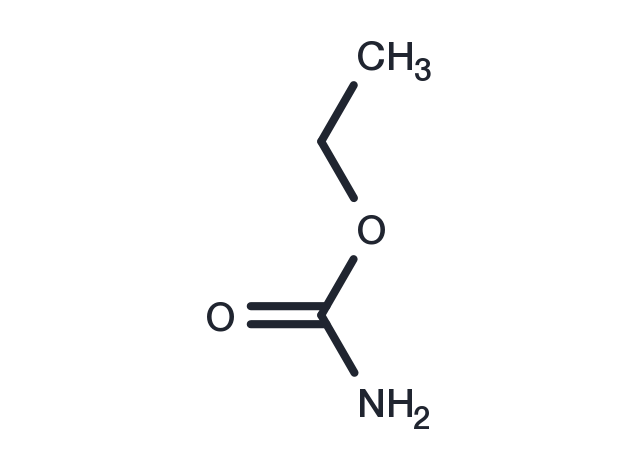Powder: -20°C for 3 years | In solvent: -80°C for 1 year
Urethane (Ethylurethane) 是多种食品中发酵形成的副产物,是氨基甲酸的乙酯,具有抑制细菌、海胆卵、原生动物和植物组织生长的作用。

| 规格 | 价格/CNY | 货期 | 数量 | |
|---|---|---|---|---|
| 500 mg | ¥ 331 | 现货 | ||
| 1 g | ¥ 415 | 现货 | ||
| 1 mL * 10 mM (in DMSO) | ¥ 415 | 现货 | ||
| 产品描述 | Urethane (Ethylurethane) was an antineoplastic agent .Now is used for other medicinal purposes. |
| 靶点活性 | AMPA receptor:34 mM(EC50), Glycine receptor:46 mM(EC50), GABAA receptor:64 mM(EC50), α4β2 nAChR:114 mM(EC50), NMDAR:70 mM(EC50) |
| 体外活性 | Urethane 对离子通道的作用与其他麻醉剂明显不同。Urethane 能显著增强GABAA和甘氨酸受体的电流反应,这种增强作用是可逆的且与浓度相关。Urethane (10-300 mM)抑制NMDA和AMPA受体的反应,增强nACh受体、神经型乙酰胆碱以及γ-氨基丁酸A和甘氨酸受体的功能[3]。 |
| 体内活性 | Urethane 是一种致癌物质,常用于急性体内电生理实验。Urethane 会影响兴奋性神经系统,但其引起的改变幅度小于其他更具选择性的麻醉剂[3]。 |
| 别名 | Ethyl carbamate, Ethylurethane, Carbamic acid ethyl ester, 氨基甲酸乙酯 |
| 分子量 | 89.09 |
| 分子式 | C3H7NO2 |
| CAS No. | 51-79-6 |
Powder: -20°C for 3 years | In solvent: -80°C for 1 year
DMSO: 125 mg/mL (1403.08 mM)
| 可选溶剂 | 浓度 体积 质量 | 1 mg | 5 mg | 10 mg | 25 mg |
| DMSO | 1 mM | 11.2246 mL | 56.123 mL | 112.246 mL | 280.6151 mL |
| 5 mM | 2.2449 mL | 11.2246 mL | 22.4492 mL | 56.123 mL | |
| 10 mM | 1.1225 mL | 5.6123 mL | 11.2246 mL | 28.0615 mL | |
| 20 mM | 0.5612 mL | 2.8062 mL | 5.6123 mL | 14.0308 mL | |
| 50 mM | 0.2245 mL | 1.1225 mL | 2.2449 mL | 5.6123 mL | |
| 100 mM | 0.1122 mL | 0.5612 mL | 1.1225 mL | 2.8062 mL |
| 中药材名称 | 中药材拉丁名 | 性 | 味 | 归经 |
| 安息香 | Styrax tonkinensis (Pierre) Craib ex Hart | 平 | 辛, 苦 | 心, 脾 |
| 中成药名称 | 处方组成 | 主治疾病 | 中成药类型 |
| 达斯玛保丸 | 铁棒锤,紫草茸,藏茜草,棘豆,多剌绿绒蒿,兔耳草,翼首草,诃子,金腰草,木香,土木香,唐古特乌头,止泻木子,安息香,人工麝香 | 口服。一次4丸,一日1~2次。 | 清热药 |
| 局方至宝散 | 水牛角浓缩粉,牛黄,玳瑁,琥珀,人工麝香,安息香,朱砂,雄黄,冰片 | 口服,一次2g,一日1次;小儿三岁以内一次0.5g,四岁至六岁一次1g;或遵医嘱。 | 开窍药 |
| 十八味欧曲丸 | 欧曲(制),铁棒锤,肉桂,藏菖蒲,安息香,红花,天竺黄,肉豆蔻,丁香,豆蔻,草果,镰形棘豆,诃子,人工麝香,乳香,决明子,黄葵子,儿茶 | 蒙医一次5~11丸,临睡前温开水服用。藏医口服,一次1丸,一日1~2次;或遵医嘱。 | 清热药 |
| 偏瘫复原丸 | 黄芪,人参,当归,川芎,赤芍,熟地黄,丹参,三七,牛膝,天麻,僵蚕(炒),全蝎,钩藤,白附子(矾炙),秦艽,地龙,铁丝威灵仙,防风,杜仲(炭),补骨脂(盐炙),骨碎补,香附(醋炙),沉香,肉桂,豆蔻仁,茯苓,泽泻,桂枝,白术(炒),枳壳(炒),麦冬,法半夏,安息香,甘草,冰片 | 用温开水或温黄酒送服。一次1丸,一日2次。 | 扶正药 |
| 二十五味阿魏胶囊 | 阿魏,野牛心,肉豆蔻,丁香,肉桂,山柰,荜茇,胡椒,安息香,乳香,石榴子,大蒜(炭),豆蔻,诃子(去核),铁棒锤,藏茴香,沉香,猴油,木香,藏木香,宽筋藤,紫草茸,黑冰片(炭),藏菖蒲,光明盐 | 口服,一次3粒,一日2次。 | 扶正药 |
| 青鹏软膏 | 棘豆,亚大黄,铁棒锤,诃子(去核),毛诃子,余甘子,安息香,宽筋藤,人工麝香 | 外用,取本品适量涂于患处,一日2次。 | 祛瘀药 |
| 肺热普清散 | 天竺黄,红花,丁香,檀香,降香,力嘎都,麝香,安息香,铁棒锤(幼苗),诃子,木香,银朱,甘草,丛菔, | 一次1g,一日2次,小儿减量。 | 清热药 |
| 大活络胶囊 | 红参,白术,甘草,熟地黄,当归,何首乌,龟甲,乳香,没药,血竭,赤芍,肉桂,两头尖,麝香,冰片,安息香,沉香,木香,丁香,香附,水牛角浓缩粉,乌药,青皮,制草乌,麻黄,细辛,羌活,防风,蕲蛇,乌梢蛇,豹骨,松香,骨碎补,天麻,天南星 | 口服,一次4粒,一日3次。 | 治风药 |
| 九味青鹏散 | 铁棒锤(幼苗),诃子(去核),藏木香,安息香,翼首草,力嘎都,兔耳草,丛菔,镰形棘豆 | 1次1g,一日2次。 | 清热药 |
| 大月晶丸 | 寒水石(制),天竺黄,红花,肉豆蔻,草果,豆蔻,丁香,诃子,余甘子,檀香,降香,木香,荜茇,石榴子,止泻木子,波棱瓜子,马钱子(制),藏木香,安息香,渣驯膏,铁粉,榜嘎,獐牙菜,兔耳草,巴夏嘎,藓生马先蒿,甘青青兰,绿绒蒿,亚大黄,蒲公英,炉甘石,欧曲(制),熊胆粉,牛黄,人工麝香 | 口服。一次3~5g,一日3次。 | 清热药 |
| 三十五味沉香丸 | 沉香,香樟,白沉香,檀香,降香,天竺黄,红花,丁香,肉豆蔻,豆蔻,草果,诃子(去核),毛诃子(去核),余甘子(去核),木香,广枣,藏木香,悬钩木,宽筋藤,山柰,木棉花,马钱子,乳香,安息香,巴夏嘎,小伞虎耳草,兔耳草,多刺绿绒蒿,打箭菊,矮垂头菊,丛菔,石榴子,铁棒锤,野牛心,麝香 | 口服。一次12~16丸(3~4g),一日2次。 | 清热药 |
| 十八味党参丸 | 藏党参,川贝,决明子,高山紫堇,渣驯膏,藏草蒲,宽筋藤,诃子,手参,毛诃子,人工麝香,乳香,黄葵子,安息香,儿茶,巴夏嘎,余甘子,木香 | 口服,一次12丸,一日3次。 | 祛湿药 |
| 脉络通片 | 郁金,人参,黄连,三七,安息香,檀香,琥珀,降香,甘松,木香,石菖蒲,丹参,麦冬,钩藤,黄芩,夏枯草,槐米,甘草,珍珠,冰片,朱砂,牛黄 | 口服,一次 4片,一日 2~ 3次。 | 祛瘀药 |
| 二十五味阿魏散 | 阿魏,野牛心,肉豆蔻,丁香,肉桂,山柰,荜茇,胡椒,安息香,乳香,石榴子,大蒜(炭),豆蔻,诃子(去核),铁棒锤,藏茴香,沉香,猴油,木香,藏木香,宽筋藤,紫草茸,黑冰片(炭),藏菖蒲,光明盐 | 一次1.2g,一日2次。"四引"(白引、酸引、红引、蒜引)为引,清晨和傍晚服用。 | 扶正药 |
| 流感丸 | 藏木香,诃子,亚大黄,木香,獐牙菜,垂头菊,丁香,镰形棘豆,酸藤果,角茴香,阿魏,榜嘎,大戟膏,草乌,安息香,藏菖蒲,龙骨,麝香,宽筋藤,牛黄,豆蔻 | 口服。一次4~8丸,一日2~3次。 | 清热药 |
| 神香苏合丸 | 人工麝香,苏合香,丁香,乳香(制),安息香,沉香,水牛角浓缩粉,冰片,香附,木香,白术 | 口服。一次0.7 g,一日1~2次。 | 理气药 |
| 萨热大鹏丸 | 诃子,安息香,蜀葵花,朱砂,山矾叶,珍珠粉,紫草茸,草乌,藏茜草,红花,豆蔻,刀豆,麝香,木香,熊胆,藏菖蒲,京墨 | 一次4~6丸,一日1~2次。 | 清热药 |
| 六锐胶囊 | 诃子(去核),红花,巴夏嘎,木香,安息香,人工麝香 | 口服。一次4粒,一日1~2次。 | 清热药 |
| 保心包 | 苏合香,川芎,丹参,三七,冰片,菊花,葛根,安息香,檀香,丁香,土木香,当归,郁金,沉香,黄芪,赤芍,香附,白芷,薤白,延胡索,决明子,降香,首乌藤,石菖蒲,乳香,没药 | 外用每袋装100g。,将药袋自密封袋中取出,放入背带中展平,戴于左侧胸壁心前区,贴紧皮肤。 每袋可持续使用3~4周,若需要可继续更换使用。3包一疗程。 | 祛瘀药 |
| 棘豆消痒洗剂 | 轮叶棘豆,岩精膏,蓖麻子,儿茶,胆矾,川西千里光,安息香,熊胆粉,麝香,硫黄(制) | 外用,直接擦洗患处;或取本品10ml兑温水100ml浸洗患处,一次15分钟,一日2次。 | 清热药 |
| 方剂名称 | 处方组成 | 剂型 | 处方来源 |
| 生犀天麻丸 | 犀牛角,天麻,独活,人参,丁香,木香,乌药,麻黄,牛黄,冰片,琥珀,乳香,朱砂,麝香,天南星,防风,白花蛇,蝎梢,川芎,安息香 | 丸剂 | 《圣济总录》卷七。 |
| 生犀天麻丸1 | 犀牛角,天麻,地榆,玄参,丁香,乌头,乌药,木香,朱砂,乳香,冰片,麝香,牛黄,朱砂,琥珀,自然铜,安息香,麻黄,白花蛇,蝎梢,天南星,防风 | 丸剂 | 《圣济总录》卷七。 |
| 吃力伽丸 | 白术,朱砂,麝香,诃子,香附,沉香,青木香,丁香,安息香,白檀香,荜茇,犀牛角,熏陆香,苏合香,冰片香 | 丸剂 | 《外台》卷十三引《广济方》。 |
| 白芥子丸 | 白芥子,防风,安息香,沉香,补骨脂,槟榔 | 丸剂 | 《圣惠》卷三。 |
| 白芜荑散 | 芜荑,附子,白槟榔,陈皮,干姜,桂枝,零陵香,安息香,八角茴香 | 散剂 | 《圣济总录》卷一○○。 |
| 五味补骨脂丸 | 补骨脂,附子,桂枝,胡桃仁,安息香 | 丸剂 | 《圣济总录》卷九十六。 |
| 牛黄丸6 | 牛黄,冰片,人参,玳瑁,朱砂,麝香,茯苓,安息香 | 丸剂 | 《圣济总录》卷十四。 |
| 无比神应膏 | 白蔹,白及,木鳖子,白芷,肉桂,杏仁,当归,乳香,没药,肉桂,苏合香,安息香,檀香,香附,木香,丁香,乳香,八角茴香,朱砂,冰片,铅丹,真芝麻油,槐枝,柳条 | 膏剂 | 《普济方》卷三一五。 |
| 内补散4 | 沉香,丁香,木香,安息香,麝香,鳖甲,柴胡,熟地黄,三棱,茯苓,人参,附子,槟榔,五味子,白芍,炙甘草,厚朴,桃仁,肉豆蔻,秦艽,知母,牛膝,白术,地骨皮,大黄, | 散剂 | 《杨氏家藏方》卷十。 |
| 牛黄丸84 | 牛黄,阿魏,朱砂,安息香,肉豆蔻,桂枝,木香,当归,槟榔,桃仁 | 丸剂 | 《圣济总录》卷一○○。 |
| 天麻丸10 | 犀牛角,天麻,独活,人参,丁香,木香,乌药,麻黄,牛膝,冰片,琥珀,乳香,朱砂,麝香,天南星,防风,白花蛇,蝎梢,川芎,安息香 | 丸剂 | 《普济方》卷九十五。 |
| 龙脑丸16 | 白龙骨脑,朱砂,琥珀,牛黄,雄黄,附子,天麻,白僵蚕,麝香,安息香,玳瑁 | 丸剂 | 《圣惠》卷二十。 |
| 白芥子丸1 | 白芥子,安息香,麝香,乌药,桃仁,陈皮 | 丸剂 | 《圣惠》卷四十三。 |
| 五香丸10 | 丁香,木香,沉香,安息香,乳香,硇砂,朱砂,肉豆蔻,桂枝,三棱,当归,陈皮,槟榔,荜澄茄,附子,巴豆 | 丸剂 | 《圣济总录》卷四十四。 |
| 灭瘢膏 | 白矾,安息香,狼毒,乌头,羊踯躅,附子,野葛,白芷,乌贼,赤石脂,皂荚,干地黄,天雄,芍药,川芎,大黄,当归,莽草,石膏,地榆,白术,续断,鬼臼,川椒,巴豆,细辛 | 膏剂 | 《千金》卷二十二。 |
| 牛膝丸2 | 牛膝,羌活,巴戟天,桂心,五加皮,杜仲,补骨脂,石斛,安息香,附子,干姜,当归 | 丸剂 | 《圣惠》卷二十三。 |
| 牛膝丸1 | 牛膝,萆薢,酸枣仁,防风,杜仲,丹参,附子,川芎,当归,桂心,羌活,茯苓,乳香,安息香,石斛 | 丸剂 | 《圣惠》卷二十一。 |
| 牛黄至宝丹1 | 人参,天竺黄,草乌,犀牛角,朱砂,雄黄,玳瑁,琥珀,麝香,冰片,金箔,银箔,牛黄,天南星,安息香 | 丸剂 | 《医林绳墨大全》卷一。 |
| 冰壶丸 | 牛黄,朱砂,人参,茯苓,安息香,胡黄连,龙胆,麦冬,远志,朱砂,玳瑁,犀牛角,冰片,龙齿,铁,甜消,金箔,银箔 | 丸剂 | 《圣济总录》卷四十三。 |
| 天麻丸28 | 天麻,蝎梢,没药,麻黄,地龙,朱砂,麝香,防风,乌头,乳香,自然铜,安息香 | 丸剂 | 《圣济总录》卷八。 |
对于不同动物的给药剂量换算,您也可以参考 更多...
请在以下方框中输入您的动物实验信息后点击计算,可以得到母液配置方法和体内配方的制备方法: 比如您的给药剂量是10 mg/kg,每只动物体重20 g,给药体积100 μL,一共给药动物10 只,您使用的配方为5% DMSO+30% PEG300+5% Tween 80+60% ddH2O。那么您的工作液浓度为2 mg/mL。
母液配置方法:2 mg 药物溶于 50 μL DMSO (母液浓度为 40 mg/mL), 如您需要配置的浓度超过该产品的溶解度,请先与我们联系。
体内配方的制备方法:取 50 μL DMSO 主液,加入 300 μL PEG300, 混匀澄清,再加 50 μL Tween 80,混匀澄清,再加 600 μL ddH2O, 混匀澄清。
您可能有的问题的答案可以在抑制剂处理说明中找到,包括如何准备库存溶液,如何存储产品,以及基于细胞的分析和动物实验需要特别注意的问题。
Urethane 51-79-6 Membrane transporter/Ion channel Microbiology/Virology Neuroscience Chloride channel GABA Receptor Antibacterial GluR NMDAR AChR Parasite inhibit carbamic narcosis mutagen acid Ethyl carbamate Inhibitor Ethylurethane Bacterial Pesticide clastogen Carbamic acid ethyl ester 氨基甲酸乙酯 inhibitor
